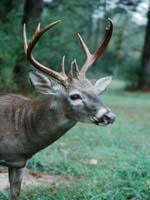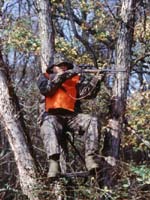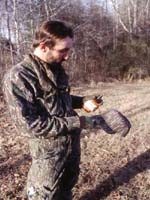
|
Features
|
|
|
|
Books
|
|
|
|
Fun & Games
|
|
|
|
Contact Us
|
|
|
John's Journal... Entry 96, Day 2
Thick-Cover Hunts
 EDITOR'S
NOTE: Often the lands containing the most deer sign won't produce
a buck. Any hunter who continues to hunt where he sees deer sign but no
deer may never take the deer making the sign.
EDITOR'S
NOTE: Often the lands containing the most deer sign won't produce
a buck. Any hunter who continues to hunt where he sees deer sign but no
deer may never take the deer making the sign.
"During the early part of deer season one year, I found a spot where deer were feeding heavily on water oak acorns," Larry Norton of Pennington, Alabama, an avid deer hunter and guide, said. "I knew that in our part of the country, deer didn't usually start feeding on white oak acorns until November. The deer seemed to be feeding heaviest on two water oak trees close to a thicket." Norton assumed that if he took a stand near the trees the deer would come out of the thicket during daylight hours and feed under the trees. However, after three days of hunting this area and seeing no bucks, Norton examined his hunting log to study notes he'd made on this property in years past.
 "You
can take more deer each season if you keep detailed notes about the places
you hunt every year," Norton commented. "Many times the history of an
area will tell you where you'll locate deer at the time you plan to hunt
a certain section of land." From his notes, Norton learned that the landowner
had clearcut this region about six years earlier. He noticed some hardwood
strips remained along the edge of a small creek running out into the thicket.
Because the clear cut had grown into a young pine plantation, Norton couldn't
spot the hardwoods in the young pines. "I found where this small creek
came out of the pine plantation," Norton explained. "I waded the creek
into the pines. After I'd gone about 100 yards, I located a spot where
the loggers had left eight or 10 water oak trees. Since I discovered plenty
of deer sign around these water oaks inside the thicket, I set up my tree
stand there. The next day I took a nice-sized 6 point and saw eight other
deer in the thicket just before dark."
"You
can take more deer each season if you keep detailed notes about the places
you hunt every year," Norton commented. "Many times the history of an
area will tell you where you'll locate deer at the time you plan to hunt
a certain section of land." From his notes, Norton learned that the landowner
had clearcut this region about six years earlier. He noticed some hardwood
strips remained along the edge of a small creek running out into the thicket.
Because the clear cut had grown into a young pine plantation, Norton couldn't
spot the hardwoods in the young pines. "I found where this small creek
came out of the pine plantation," Norton explained. "I waded the creek
into the pines. After I'd gone about 100 yards, I located a spot where
the loggers had left eight or 10 water oak trees. Since I discovered plenty
of deer sign around these water oaks inside the thicket, I set up my tree
stand there. The next day I took a nice-sized 6 point and saw eight other
deer in the thicket just before dark."
 Apparently
the deer would remain in the thicket and feed on the water oaks until
dark and then move down the creek and into the open woods to feed on the
water oaks after dark where Norton first had set up his stand. "If you
find sign that lies about where deer should appear during daylight hours,
follow them from their feeding sites and back to their bedding areas,"
Norton recommended. "If you can locate any sign between the feeding and
the bedding region where deer may eat before they come to their primary
feeding area, more than likely you'll take a buck there."
Apparently
the deer would remain in the thicket and feed on the water oaks until
dark and then move down the creek and into the open woods to feed on the
water oaks after dark where Norton first had set up his stand. "If you
find sign that lies about where deer should appear during daylight hours,
follow them from their feeding sites and back to their bedding areas,"
Norton recommended. "If you can locate any sign between the feeding and
the bedding region where deer may eat before they come to their primary
feeding area, more than likely you'll take a buck there."
TOMORROW: Greenfield Hunts
Check back each day this week for more about Lying Sign ...
Day 1 -Deer Sign that Lies
Day 2 -Thick-Cover Hunts
Day 3 -Greenfield Hunts
Day 4 -Deer-Movement Patterns
Day 5 -Alternative Food Source